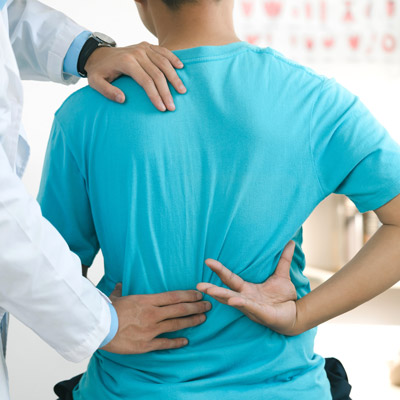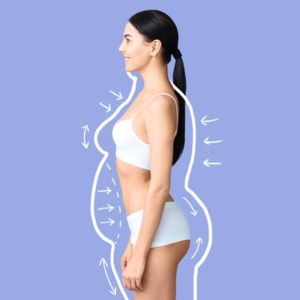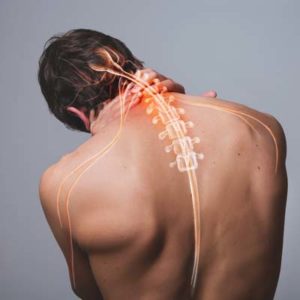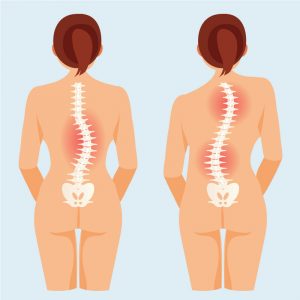Last Modified on June 25, 2025 by Dr. Tyler Meier

When you first hear the term “thoracolumbar scoliosis,” it might sound overwhelming. Unlike general scoliosis information that covers all spinal curves, thoracolumbar scoliosis affects a very specific region of your spine. This targeted approach to understanding your condition is crucial because the treatment strategies and outcomes can differ significantly from other types of spinal curvature. Let’s dive into what you need to know about this particular form of scoliosis.
What Is Thoracolumbar Scoliosis?
Anatomy & Definition
Thoracolumbar scoliosis is a sideways curvature of the spine that occurs at the junction between your mid-back (lower thoracic region) and your lower back (upper lumbar region). Think of it as the “transition zone” where your rib cage ends and your lower back begins – typically around the T11-L2 vertebrae.
This location is particularly significant because it’s where your spine naturally transitions from the more rigid thoracic region, which is supported by your rib cage, to the more mobile lumbar region. When scoliosis develops in this area, it can affect both the stability provided by your ribs and the flexibility needed in your lower back.
Dr. Stuart Weinstein’s landmark research in the Journal of Bone and Joint Surgery demonstrates that the location of spinal curvature significantly impacts both progression risk and treatment outcomes. This is why understanding your specific type of scoliosis matters so much.
Types & Direction
We classify thoracolumbar scoliosis based on the direction of the curve. Dextroscoliosis curves to the right (when viewed from behind), while levoscoliosis curves to the left. In thoracolumbar cases, dextroscoliosis is more common, though both types respond well to appropriate treatment.
What Causes Thoracolumbar Scoliosis?
The Three Main Types
- Idiopathic Scoliosis (80%+) – Cause unknown, likely involves genetic and environmental factors
- Congenital Scoliosis – Present from birth due to abnormal vertebrae formation during fetal development
- Neuromuscular Scoliosis – Develops from conditions affecting muscle control, creating imbalanced forces on the spine
Key Risk Factors:
- Family history – Genetic predisposition significantly increases your risk
- Growth spurts – Adolescent growth periods can accelerate curve progression
- Age-related changes – Spinal degeneration in adults can contribute to curve development
- Previous injuries – Trauma may sometimes trigger or worsen curvature
The bottom line? While we can’t always pinpoint why scoliosis develops, understanding these factors helps us create more effective prevention and treatment strategies.
Recognizing the Symptoms
Visual Signs
One of the challenges with scoliosis is that it often develops gradually, making early signs easy to miss. However, there are several visual cues to watch for:
Uneven shoulders are often the first sign parents notice in children. One shoulder may appear higher than the other, or clothing may hang unevenly.
Similarly, an uneven waistline can indicate spinal curvature – one side may appear to have more space between the arm and torso.
Rib prominence is another telltale sign, particularly noticeable when bending forward. This occurs because the vertebral rotation associated with scoliosis causes the ribs to become more prominent on one side of the back.
Pain & Physical Symptoms
Thoracolumbar scoliosis can lead to several physical symptoms:
- Back pain is more common in adult patients and those with larger curves. The pain often results from muscle imbalances and compensatory patterns your body develops to maintain balance and function.
- Nerve issues can occur if the spinal curvature affects nerve pathways. This might manifest as tingling, numbness, or weakness in the legs or feet.
- Fatigue is frequently overlooked but very real. Your body works harder to maintain posture and balance when dealing with spinal asymmetry, leading to increased energy expenditure throughout the day.
In severe cases, breathing issues can develop if the thoracic component of the curve significantly impacts lung capacity. However, this is less common with thoracolumbar curves compared to purely thoracic scoliosis.
Diagnosis & Assessment
Clinical Exam
When you visit our clinic, we start with a comprehensive approach that goes far beyond just looking at your spine. We take a detailed medical and family history to understand any genetic predispositions and identify potential contributing factors.
The physical examination includes posture analysis from multiple angles, gait assessment, and various orthopedic and neurological tests. We use tools like the Adam’s Forward Bend Test to assess rib prominence and spinal rotation. Range of motion testing helps us understand how the curvature affects your spine’s mobility.
Imaging Tools
X-ray imaging remains the gold standard for scoliosis diagnosis and monitoring. We use full-spine X-rays to measure the Cobb angle – the standardized method for quantifying spinal curvature. Curves are classified as:
- Mild: 10-25 degrees
- Moderate: 25-45 degrees
- Severe: 45+ degrees
MRI or CT scans may be recommended if we need to evaluate soft tissues, check for spinal cord abnormalities, or assess spinal canal narrowing. These advanced imaging tools help us rule out underlying conditions and plan the most appropriate treatment approach.
Non-Surgical Treatment Options
When it comes to non-surgical scoliosis treatment, we believe every patient deserves an individualized approach. At CorePosture Chiropractic, I work closely with each patient to develop comprehensive treatment plans that address their unique spinal curvature and lifestyle needs.
Our clinic utilizes cutting-edge technology, including 3D body scanning, to ensure precision in every aspect of care – especially when custom bracing is indicated. This advanced approach allows us to capture exact measurements and create truly personalized treatment solutions.
Your Treatment Journey with Us:
- Comprehensive Evaluation – We begin with a thorough scoliosis assessment, discussing your symptoms, medical history, and personal treatment goals to understand the complete picture of your condition.
- Advanced 3D Analysis – Using state-of-the-art scanning technology, we capture precise body contours and spinal alignment data, enabling us to design custom treatment approaches tailored specifically to your curve pattern.
- Custom Treatment Implementation – Whether it’s a ScoliBrace fitting or other therapeutic interventions, we ensure proper implementation and provide detailed guidance on usage and care protocols.
- Continuous Progress Monitoring – Regular follow-up appointments allow us to track your improvement, make necessary adjustments, and adapt your treatment plan as your condition responds to care.
This systematic approach ensures that you receive the most effective non-surgical treatment possible, with the ongoing support needed to achieve optimal outcomes for your thoracolumbar scoliosis.
At CorePosture Chiropractic in Newport Beach, we specialize in comprehensive scoliosis management using evidence-based approaches tailored to each patient’s unique needs. If you’re dealing with thoracolumbar scoliosis, we’re here to help you navigate your treatment options and achieve your best possible outcomes.
Frequently Asked Questions
Can adults still improve their spinal curvature? While skeletal maturity means curves are less likely to worsen rapidly, adults can often improve their posture, reduce pain, and enhance function through targeted treatment approaches.
How often do I need X-rays? This depends on your age, curve severity, and current symptoms. Growing adolescents typically need more frequent monitoring (every 6-12 months), while stable adult curves may only require annual imaging.
Are there risks to non-surgical treatment options? Conservative treatments like exercise, bracing, and chiropractic care carry minimal risks when provided by qualified professionals. The benefits typically far outweigh any potential concerns.
How many hours daily should a brace be worn? For maximum effectiveness in growing adolescents, research supports wearing braces 13+ hours daily. However, this varies based on individual circumstances and should be determined with your healthcare provider.

Dr. Tyler Meier is a board-certified, licensed chiropractor and founder of CorePosture Chiropractic in Newport Beach, CA







